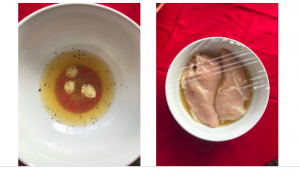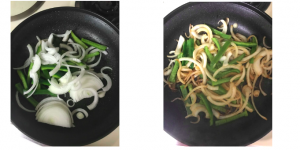Recipe Blog: Cuban Fricasé de Pollo
By Nora_Stone • December 14, 2018
I love eating Cuban food, but it has always been prepared at a restaurant. The seasoned meats typical of Cuban cuisine always intimidated. I felt too inexperienced at cooking to even attempt making Cuban food. As I scrolled through a trove of recipes on Google, I started to lose hope in finding anything I would be able to tackle in my kitchen. Then, I came across Fricasé de Pollo. Fricasé dishes can be found in cultures all over the world. It is similar to the French dish Fricassee which usually consists of stewed meat in a white sauce. As a result of French colonization in the Caribbean, Fricasé is found in Puerto Rico and Cuba where a red sauce is used. In Cuba, this dish considered comfort food and doubles as a hangover cure after a night of drinking one too many mojitos.
This recipe was taking from Saveur.com: Click here to check it out.
Ingredients:
- 1⁄4 cup fresh lime juice
- 1⁄4 cup fresh orange juice
- 3 cloves garlic, lightly smashed
- 1 (3 1⁄2–4-lb.) chicken, quartered (backbone discarded or saved for stock)
- 1⁄3 cup olive oil
- 1 large green bell pepper, stemmed, seeded, and thinly sliced
- 1 large white onion, thinly sliced
- 1 cup dry white wine
- 1 lb. russet potatoes, peeled and cut into 1″ pieces
- 1⁄2 cup jarred alcaparrado or 1⁄3 cup pimento-stuffed olives and 2 tbsp. capers
- 1⁄4 cup raisins
- 1 cup frozen peas, defrosted
- 1 (8-oz.) can tomato sauce
- Kosher salt and freshly ground black pepper, to taste
The first step is making the marinade for the chicken. Begin by pouring juices from two limes and one orange into a large bowl. I used fresh orange and lime juice, but store bought lime juice would work as well. (Best way to juice a lime.) Next, the recipe calls for three “lightly smashed” cloves of garlic. (How to smash garlic.) These will also go into the large bowl with the juice. The marinade is very simple. The only ingredients left are salt and pepper. However, there are no measurements for this, so I used roughly two pinches of salt and a dash of pepper.

The marinade is ready for the chicken! I opted for two large chicken breasts for this recipe because I don’t like bones. I had no issues with this adjustment to the recipe. Once in the bowl of marinade, make sure to coat the breasts in the juice by turning them a few times. Then, cover the bowl with cling wrap and place in the fridge for one hour.
While the marinating is in progress, I decided to peel my three potatoes. This is the point where I ran into some issues. I did not own a potato peeler. For those who do not know, cutting off potato skin with a knife is both tedious and dangerous. Therefore, I recommend picking up a peeler at the store if you do not already own one. It is important to note that like avocados and apples, when peeled potatoes oxidize quickly. To avoid any unsightly potatoes, cover them with cold water in a bowl until they are ready to cook. 
For the stew, the potatoes are instructed to be cut into 1” pieces. Below are visual instructions of how I sliced mine.

Since my chicken still had a while to go before it was done marinating, I decided to continue preparing the rest of my ingredients. I sliced my green pepper and onion. (Easy way to slice green pepper and the correct way to thinly slice an onion.) Once this step was complete, I placed the onion and pepper the fridge until they were ready to be sauted. This is a good time to take frozen peas out of freezer to being thawing.

 Once the chicken is ready to be cooked, this recipe picks up pace pretty quickly. So far, I was feeling confident and relaxed. Everything was going according to plan. To ensure it continued this way, I decided to gather everything I would need for the last half of the recipe: ingredients, measuring cups, and extra paper towels. I recommend this precaution.
Once the chicken is ready to be cooked, this recipe picks up pace pretty quickly. So far, I was feeling confident and relaxed. Everything was going according to plan. To ensure it continued this way, I decided to gather everything I would need for the last half of the recipe: ingredients, measuring cups, and extra paper towels. I recommend this precaution.
It was time. The chicken was ready to be cooked. Now, if you’re using breast, I recommend slicing the chicken into large strips. One of my chicken breasts was a little over two inches thick at one end. This took forever to cook, so consider the thickness when making your own.
The directions say to heat 1⁄3 cup of olive oil in the saute pan on medium-high. Here is where the trouble began. Suddenly, hot oil sputtered up from the pan. Flying onto my bare arms. A brief panic ensued. Luckily, I was not badly injured. All joking aside, hot oil on skin is not fun so, I would use something closer to 4 tablespoons at low heat. This will prevent the oil from bubbling out of the pan. Now, you can remove the chicken from the bowl, pat dry with a paper towel, and place in the pan.
I cooked each side for about 15 minutes. There should be a golden brown color on the bottom. Remember, a fully cooked chicken is 165 degrees. Use this as your guide for when your chicken is ready. Remove chicken from pan and place on plate.
Next, phase two commenced. I transferred the sliced onion and pepper into the pan with a little more olive oil. These sat on medium-low heat for seven minutes. They should look like this when ready (soft and a light browning of the onion):

Next, the cup of white wine was added to the pan and will sit for another seven minutes on medium-low.
Finally, place the cooked chicken back in the pan. Pour in the leftover marinade. Add all of your potatoes, green olives, raisins, tomato sauce, salt, pepper, and 1⁄2-cup water. The pan will likely be full. Don’t worry. The pan will be covered, so all the food on top will be cooked. The heat should be medium-low while it sits for 45 minutes. Don’t forget to cover the pan. Soft potatoes are a sign it is ready to be eaten. Add the the peas when you’re ready to serve and top with a few capers.

Delicioso!
I thoroughly enjoyed this dish. It was flavorful and filling. Initially, I was concerned it would lack flavor because the only spices were salt and pepper, but I was pleasantly surprised. The stew was a mixture of salty, savory, garlicky, and sometimes a hint of sweetness because of the raisins. It provided a hearty dinner for a few days and was just as delicious reheated!
